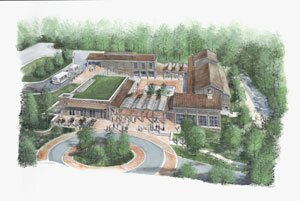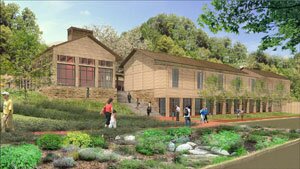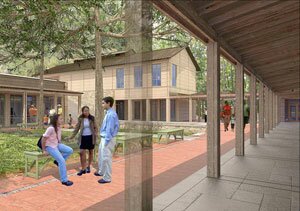ONARCHITECTURE- What bonds can build: Monticello's new visitor center

Monticello's new $55 million, 42,000-sq.-ft. visitor center should be finished by 2009, just in time for TJ's 266th birthday.
PHOTOS COURTESY THOMAS JEFFERSON MEMORIAL FOUNDATION
Plans for a new visitor center at Monticello have been a long time on the drawing board.
"It was being talked about long before I got here," says communications director Wayne Mogielnicki. "I'd say at least ten years."
In 2000, when the UVA Foundation took control of the Blue Ridge Sanatorium property just below Monticello, it looked like a new center was finally going to become a reality. State legislators approved the transfer with the understanding that Monticello's new visitor center would be located on the site, along with a planned research park along the lines of the Fontaine Research Park. However, due to "design concerns" on Monticello's part, and a fear of commitment on the part of the UVA Foundation, the new visitor center has been in limbo since.
"UVA wasn't ready... they had no real vision for the site," says Kat Imhoff, vice president of the Thomas Jefferson Foundation, the organization that runs Monticello. "I think they're still trying to decide what to do with it."
Pressing on, the TJ Foundation elected to build its new visitor center on the site of the old ticket office and shuttle station, a ramshackle grey wood building reminiscent of state park picnic shelters, which was demolished earlier this year. In March, excavation began on the new $55 million, 42,000-sq.-ft. Thomas Jefferson Visitor Center and Smith History Center. (The project also includes an operating endowment of $12 million.)
As first noted locally by the Hook, $30 million is being raised through the sale of municipal bonds, the rest coming from private donations.
–>
–>
Designed by the Baltimore-based architecture firm Ayers-Saint-Gross– one of 22 firms Monticello invited to submit proposals– the complex is scheduled to open in the fall of 2008, with related work continuing until 2009. Incidentally, Ayers-Saint-Gross is also designing a $15 million addition to the South Chiller Plant and Thermal Energy Storage system for UVA, which will supply power to the expanding health care and medical research areas on grounds.
Unlike the old ticket office, the visitor center will be a destination in itself, comparable in educational value– if not architectural splendor– to the building on the hill it serves. It will also allow Monticello to remove some commercial and administrative offices from around the house, as the gift shop and select offices will be relocated to the new center.
"Our long-term goal is to restore Monticello to 1809," says Mogielnicki, "and remove all the 20th and 21st century buildings from the mountain."
Mogielnicki calls the visitor center just a first step in that direction, as the curatorial department, guide offices, and central administration offices will remain on the mountain until additional space is found. Mogielnicki says they'll also abandon the leased museum space in the Charlottesville/Albemarle visitor center at the foot of Piedmont Virginia Community College, as a new two-story pavilion will house permanent and ongoing exhibitions.
The design features five pavilions around a central courtyard and is intended to "blend into the landscape." Indeed, architectural renderings of the complex make it look more like a stylish mountain retreat than a tourist attraction. It will be constructed of local natural materials like fieldstone from Greene County and recycled pine flooring, and will include a "green" roof and other environmentally correct features.
One notable feature is a geothermal comfort system, which takes advantage of the constant temperature beneath the earth to heat and cool buildings on the surface. Seventy-two "wells" have already been dug on the site to transfer those steady temps to the buildings. In addition, storm water will be stored and filtered via step ponds along walkways, huge storage pipes under the new parking lots, and filtration systems at points where water will collect.
In addition to the two-story exhibition pavilion, another two-story pavilion will house the Smith Center, a classroom and "hands-on" activity center with a theater. There will also be a café building, plenty of outdoor places to congregate, and an educational pavilion connected to the complex by a wooded path.

The Carl Smith History Center

View of the central courtyard.
#